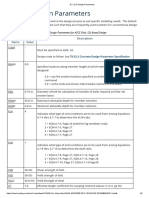Sloping Benching
Sloping Benching
Uploaded by
GANESHCopyright:
Available Formats
Sloping Benching
Sloping Benching
Uploaded by
GANESHCopyright
Available Formats
Share this document
Did you find this document useful?
Is this content inappropriate?
Copyright:
Available Formats
Sloping Benching
Sloping Benching
Uploaded by
GANESHCopyright:
Available Formats
TrenchingandExcavationOperations
SLOPINGANDBENCHINGSYSTEMS
OBJECTIVES
Uponthecompletionofthissection,theparticipantshouldbeableto:
1. Describe the difference between maximum allowable slope and
actualslope.
2. Observehowtheangleofvariousslopedsystemsvarieswithsoil
type.
3. Evaluatelayeredsystemstodeterminethepropertrenchslope.
4. Illustrate how shield systems and sloping systems interface in
combinationsystems.
HMTRI2000 Page42 Trenching
REV1
TrenchingandExcavationOperations
SLOPINGSYSTEMS
If enough surface room isavailable, slopingor benchingthe trench walls
willofferexcellentprotectionwithoutanyadditionalequipment.Cuttingtheslope
oftheexcavationbacktoitsprescribedanglewillallowtheforcesofcohesion(if
present) and internal friction to hold the soil together and keep it from flowing
downsthefaceofthetrench.Thesoiltypeprimarilydeterminestheexcavation
angle.
Sloping a method of protecting employees from caveins by excavating to
form sides of an excavation that are inclined away from the
excavationssoastopreventcaveins.
Inpractice,itmaybedifficulttoaccuratelydeterminetheseslopingangles.
Mostofthetime,thedepthofthetrenchisknownorcaneasilybedetermined.
Based on the vertical depth, the amount of cutback on each side of the trench
can be calculated. A formula to calculate these cutback distances will be
included with each slope diagram. NOTE: Remember, the beginning of the
cutback distance begins at the toe of the slope, not the center of the trench.
Accordingly, the cutback distance will be the same regardless of how wide the
trenchisatthebottom.
HMTRI2000 Page43 Trenching
REV1
TrenchingandExcavationOperations
OSHA provides slope information based on the maximum allowable slope.
Tousethemaximumallowableslope,siteconditionsmustbeideal.Ifanysigns
of distress are observed, the actual slope is required to be less than the
maximumallowableslope.SignsofdistressthatOSHAlistsare:
Developmentoffissuresintrenchface
Appearanceofstresscracks
Materialslumpingfromface
Bulgingorheavingofthetrenchbottom
Spallingorraveling.
Ifthisoranyotherconditionisobservedwhichthecompetentpersonbelieves
would jeopardize the integrity of the trench, the steepest slope which can be
used is the maximum allowable slope plus an additional 1/2H: 1V. This is the
steepest actual slope. Depending upon conditions, theangle of this slope may
havetobefurtherreducedtoprovideadequateprotection.Whilenotasspecific,
the Standard states that the competent person must allow a safety factor
(decrease the slope) in situations where surcharge loads, or vibration could
weakentheslopewallsaswell.
The prescribed sloping angles andbenchdimensions can bedetermined by
usinganyofthefollowingoptions:
1. AssumeTYPECsoil.Thisgivesamaximumallowableslopeof34degrees
(1.5H:1V).Nobenchingisallowed.Soiltestingisnotrequired.
2. UseofTabulatedDataapprovedbyaRegisteredProfessionalEngineer.
Datamustincludesystemselectionparameters,datalimits,andexplanatory
information. A copy of the tabulated data is required to be at the job site
duringconstruction.Soiltestingrequired.
3. Use a slope or benching configuration designed by a Registered
ProfessionalEngineer.Acopyofthedesigndataisrequiredtobeatthejob
siteduringconstruction.Soiltestingrequired.
4. Use Appendix A (Soil Testing) and Appendix B (Sloping and Benching).
Soiltestingrequired.
HMTRI2000 Page44 Trenching
REV1
TrenchingandExcavationOperations
APPENDIXBSimpleSlopingSystemsforTYPEASoil
ForTYPEAsoilandatrenchdepthoflessthan20feet,thesteepestmaximum
allowableslopeis53degreesfromthehorizontal.Thistranslatestoa0.75H:1V
inclineandisshownbelow.
MaximumAllowableSlope
Cutbackdistance(H)=0.75xDepth(V)
SteepestActualSlope
Cutbackdistance(H)=1.25xDepth(V)
HMTRI2000 Page45 Trenching
REV1
TrenchingandExcavationOperations
Manytrenchesareopenforsuchashorttimethatthe
cohesiveTYPEAsoilhasnotimetodryout.Therefore,OSHA
allowsforasteepermaximumallowableslopeforthosetrenches,
whichare12feetorlessindepthandwillremainopenforlessthan
24hours.
ForTYPEAsoilandatrenchdepthoflessthan12feetfora
trenchopen24hoursorless,thesteepestmaximumallowable
slopeis63degreesfromthehorizontal.Thistranslatestoa0.5H:
1Vinclineandisshownbelow.
MaximumAllowableSlope
Cutbackdistance(H)=0.5xDepth(V)
SteepestActualSlope
Cutbackdistance(H)=1.0xDepth(V)
HMTRI2000 Page46 Trenching
REV1
TrenchingandExcavationOperations
APPENDIXBSimpleSlopingSystemforTYPEBSoil
TYPE B soil is not as stable as TYPE A. and the incline for the sloped
systemisnotasgreatasitwouldbeforTYPEAsoils.
For TYPE B soil and a trench depth of less than 20 feet, the steepest
maximumallowableslopeis45degreesfromthehorizontal.Thistranslatestoa
1H:1Vinclineandisshownbelow.
MaximumAllowableSlope
Cutbackdistance(H)=1.0xDepth(V)
SteepestActualSlope
Cutbackdistance(H)=1.5xDepth(V)
HMTRI2000 Page47 Trenching
REV1
TrenchingandExcavationOperations
APPENDIXBSimpleSlopingSystemforTYPECSoil
TheinclineofaslopeforTYPECsoilistheflattestsinceTYPECsoilis
theleastcohesiveandthemostflowable.
For TYPE C soil and a trench depth of less than 20 feet, the steepest
maximumallowableslopeis34degreesfromthehorizontal.Thistranslatestoa
1H:1.5Vinclineandisshownbelow.
MaximumAllowableSlope
Cutbackdistance(H)=1.5xDepth(V)
SteepestActualSlope
Cutbackdistance(H)=2.0xDepth(V)
HMTRI2000 Page48 Trenching
REV1
TrenchingandExcavationOperations
BENCHINGSYSTEMS
Rather than excavating a flat trench face, benching leaves steps on the
sideoftheexcavation.Thiscaneitherbefoundasasinglebenchatthebottom
of the trench or a multiple bench system. There are really two main reasons to
benchatrenchratherthanslopeatrench.Ofgreatestimportanceistheaffectit
hasontheweightthattheburiedconduitmustbear.ThroughworkdoneatIowa
State University, it has been shown that allowing a bench above the conduit to
bear some of the lateral weight (force) of the soil canlessen soil weight, which
theconduitmustsupport.
APPENDIXBBenchSystemsforTypeASoil
ForsimplebenchsystemsinTYPEAsoilandatrenchdepthoflessthan
20feet,thesteepestmaximumallowableslopeis53degreesfromthehorizontal.
Thistranslatestoa0.75H:1Vinclineandisshownbelow.
MaximumAllowableSlope
Cutbackdistance(H)=.75xDepth(V)
SteepestActualSlope
Cutbackdistance(H)=1.25xDepth(V)
HMTRI2000 Page49 Trenching
REV1
TrenchingandExcavationOperations
FormultiplebenchsystemsinTYPEAsoilandtrenchdepthoflessthan
20feet,thesteepestmaximumallowableslopeis53degreesfromthehorizontal.
Thistranslatestoa0.75H:1Vinclineandisshownbelow.
MaximumAllowableSlope
Cutbackdistance(H)=.75xDepth(V)
SteepestActualSlope
Cutbackdistance(H)=1.25xDepth(V)
HMTRI2000 Page50 Trenching
REV1
TrenchingandExcavationOperations
APPENDIXBBenchSystemsforTYPEBSoil
ForsimplebenchsystemsinTYPEBsoilandtrenchdepthoflessthan20
feet, the steepest maximum allowable slope is 45 degrees from the horizontal.
Thistranslatestoa1H:1Vinclineandisshownbelow.
MaximumAllowableSlope
Cutbackdistance(H)=1.0xDepth(V)
SteepestActualSlope
Cutbackdistance(H)=1.5xDepth(V)
FormultiplebenchsystemsinTYPEBsoilandatrenchdepthoflessthan
20feet,thesteepestmaximumallowableslopeis45degreesfromthehorizontal.
Thistranslatestoa1H:1Vinclineandisshownbelow.
MaximumAllowableSlope
Cutbackdistance(H)=1.0xDepth(V)
SteepestActualSlope
Cutbackdistance(H)=1.5xDepth(V)
HMTRI2000 Page51 Trenching
REV1
TrenchingandExcavationOperations
COMBINATIONSLOPED/BENCHEDSYSTEMS
Avariationontheslopingandbenchingconceptyieldsthishybrid,which
is widely used. In this combination, the bottom of the trench face is vertical.
Towardthetop,thetrenchfaceisslopedback.
APPENDIXBCombinationSystemsforTYPEASoil
Forcombinationslope/benchsystemsinTYPEAsoilandatrenchdepth
oflessthan8feet,thesteepestmaximumallowableslopeis53degreesfromthe
horizontal. This translates to a 0.75H: 1V incline and is shown below. The
maximumheightoftheverticallowerportions3.5feet.
MaximumAllowableSlope
Cutbackdistance(H)=.75xDepth(V)
SteepestActualSlope
Cutbackdistance(H)=1.25xDepth(V)
Thissystemisfavorablefromapipeweightloadingstandpointandcanbe
quicklyexcavated.Itallowsshorttrenchboxedorshieldssystemstobeusedin
deepertrenches.Further,inTYPEAsoils,theverticalportionatthebottomcan
remain unsupported. Therefore, a relatively deep trench can be excavated with
minimalsloping.
HMTRI2000 Page52 Trenching
REV1
TrenchingandExcavationOperations
Forcombinationslope/benchsystemsinTYPEAsoilandatrenchdepth
greaterthan8feetbutlessthan12feet,thesteepestmaximumallowable
slopeis45degreesfromthehorizontal.Thistranslatestoa1H:1Vincline
andis shown below. The maximum height of the verticallower portionis
3.5feet.
MaximumAllowableSlope
Cutbackdistance(H)=.75xDepth(V)
SteepestActualSlope
Cutbackdistance(H)=1.25xDepth(V)
Forcombinationslope/benchsystemsinTYPEAsoilandatrenchdepth
of less than 20 feet, the steepest maximum allowable slope is 53degrees from
the horizontal. It is allowed only if a trench supports or shield is used. This
translates to a 0.75H: 1V incline and is shown below. The trench shield must
extendatleast18inchesabovethetopoftheverticalside.
MaximumAllowableSlope
Cutbackdistance(H)=.75xDepth(V)
SteepestActualSlope
Cutbackdistance(H)=1.25xDepth(V)
HMTRI2000 Page53 Trenching
REV1
TrenchingandExcavationOperations
APPENDIXBCombinationSystemforTYPEBSoil
TheonlyoptionforcombinationsystemsinTYPE BorTYPECsoilsare
whenasupportorshieldsystemguardstheverticalside.
Forcombinationslope/benchsystemsinTYPEBsoilandatrenchdepth
of less than 20 feet, the steepest maximum allowable slope is 45degrees from
thehorizontalisallowedonlyifatrenchsupportorshieldisused.Thistranslates
toa1H:1Vinclineandisshownbelow.Thetrenchshieldmustextendatleast18
inchesabovethetopoftheverticalside.
MaximumAllowableSlope
Cutbackdistance(H)=.75xDepth(V)
SteepestActualSlope
Cutbackdistance(H)=1.25xDepth(V)
HMTRI2000 Page54 Trenching
REV1
TrenchingandExcavationOperations
APPENDIXBCombinationSystemforTYPECSoil
Forcombinationslope/benchsystemsinTYPECsoilandatrenchdepth
of less than 20 feet, the steepest maximum allowable slope is 34degrees from
thehorizontalisallowedonlyifatrenchsupportorshieldisused.Thistranslates
toa1.5H:1Vinclineandisshownbelow.Thetrenchshieldmustextendatleast
18inchesabovethetopoftheverticalside.
MaximumAllowableSlope
Cutbackdistance(H)=.75xDepth(V)
SteepestActualSlope
Cutbackdistance(H)=1.25xDepth(V)
LAYEREDSYSTEMS
Digging in layered systems is essentially like digging two separate
trenches one on top of the other. In Appendix B, OSHA recognizes systems
composed of only two layers. If more than two layers are encountered, sloping
shouldbedesignedtodealwiththeweakestsoiltype.
Twothemesrunthroughthelayeredsoilsslopingcriteria:
1. If the stronger soil is below the weaker soil, the sloping for each layeris
thesameasthesimpleslopeforthatsoiltype.
HMTRI2000 Page55 Trenching
REV1
TrenchingandExcavationOperations
2. If the stronger soil is above the weaker soil, the entire system is sloped
accordingtotheweakersoilssimpleslope.
The following diagrams will illustrate layered system sloping angles. When
calculatingcutbackdistances,assumethatthetoeofthetoplayeristhatpointon
thetrenchfacewherethetoplayerbegins.
HMTRI2000 Page56 Trenching
REV1
TrenchingandExcavationOperations
Surchargeloadsmustbeplacedatleast2feetbackfromtheedgeofthe
trench.Whenspoilorsurchargeloadsareplacedatthetopofslopedorbenched
systems,theymuststayatleast2feetbackoffromtheedge.Further,thecenter
of the spoil pile can be no closer than the imaginary line formed by the
continuation of the slope. This is true for positioning outriggers on heavy
equipmentaswell.
HMTRI2000 Page57 Trenching
REV1
You might also like
- The Subtle Art of Not Giving a F*ck: A Counterintuitive Approach to Living a Good LifeFrom EverandThe Subtle Art of Not Giving a F*ck: A Counterintuitive Approach to Living a Good LifeRating: 4 out of 5 stars4/5 (5943)
- The Gifts of Imperfection: Let Go of Who You Think You're Supposed to Be and Embrace Who You AreFrom EverandThe Gifts of Imperfection: Let Go of Who You Think You're Supposed to Be and Embrace Who You AreRating: 4 out of 5 stars4/5 (1108)
- Never Split the Difference: Negotiating As If Your Life Depended On ItFrom EverandNever Split the Difference: Negotiating As If Your Life Depended On ItRating: 4.5 out of 5 stars4.5/5 (887)
- Hidden Figures: The American Dream and the Untold Story of the Black Women Mathematicians Who Helped Win the Space RaceFrom EverandHidden Figures: The American Dream and the Untold Story of the Black Women Mathematicians Who Helped Win the Space RaceRating: 4 out of 5 stars4/5 (925)
- Grit: The Power of Passion and PerseveranceFrom EverandGrit: The Power of Passion and PerseveranceRating: 4 out of 5 stars4/5 (598)
- Shoe Dog: A Memoir by the Creator of NikeFrom EverandShoe Dog: A Memoir by the Creator of NikeRating: 4.5 out of 5 stars4.5/5 (545)
- The Hard Thing About Hard Things: Building a Business When There Are No Easy AnswersFrom EverandThe Hard Thing About Hard Things: Building a Business When There Are No Easy AnswersRating: 4.5 out of 5 stars4.5/5 (354)
- Elon Musk: Tesla, SpaceX, and the Quest for a Fantastic FutureFrom EverandElon Musk: Tesla, SpaceX, and the Quest for a Fantastic FutureRating: 4.5 out of 5 stars4.5/5 (476)
- Her Body and Other Parties: StoriesFrom EverandHer Body and Other Parties: StoriesRating: 4 out of 5 stars4/5 (831)
- The Emperor of All Maladies: A Biography of CancerFrom EverandThe Emperor of All Maladies: A Biography of CancerRating: 4.5 out of 5 stars4.5/5 (274)
- The World Is Flat 3.0: A Brief History of the Twenty-first CenturyFrom EverandThe World Is Flat 3.0: A Brief History of the Twenty-first CenturyRating: 3.5 out of 5 stars3.5/5 (2272)
- The Little Book of Hygge: Danish Secrets to Happy LivingFrom EverandThe Little Book of Hygge: Danish Secrets to Happy LivingRating: 3.5 out of 5 stars3.5/5 (419)
- The Yellow House: A Memoir (2019 National Book Award Winner)From EverandThe Yellow House: A Memoir (2019 National Book Award Winner)Rating: 4 out of 5 stars4/5 (99)
- Devil in the Grove: Thurgood Marshall, the Groveland Boys, and the Dawn of a New AmericaFrom EverandDevil in the Grove: Thurgood Marshall, the Groveland Boys, and the Dawn of a New AmericaRating: 4.5 out of 5 stars4.5/5 (270)
- The Sympathizer: A Novel (Pulitzer Prize for Fiction)From EverandThe Sympathizer: A Novel (Pulitzer Prize for Fiction)Rating: 4.5 out of 5 stars4.5/5 (122)
- Team of Rivals: The Political Genius of Abraham LincolnFrom EverandTeam of Rivals: The Political Genius of Abraham LincolnRating: 4.5 out of 5 stars4.5/5 (235)
- A Heartbreaking Work Of Staggering Genius: A Memoir Based on a True StoryFrom EverandA Heartbreaking Work Of Staggering Genius: A Memoir Based on a True StoryRating: 3.5 out of 5 stars3.5/5 (232)
- On Fire: The (Burning) Case for a Green New DealFrom EverandOn Fire: The (Burning) Case for a Green New DealRating: 4 out of 5 stars4/5 (75)
- Overview of Cp52Document0 pagesOverview of Cp52Ban NguyễnNo ratings yet
- The Unwinding: An Inner History of the New AmericaFrom EverandThe Unwinding: An Inner History of the New AmericaRating: 4 out of 5 stars4/5 (45)
- Examples 8.3 and 8.4Document12 pagesExamples 8.3 and 8.4itissa INGENIERIANo ratings yet
- 200 X 150 CNHA 5 45 - Horizontal Split Case Pump Data SheetDocument5 pages200 X 150 CNHA 5 45 - Horizontal Split Case Pump Data Sheetسمير البسيونىNo ratings yet
- SN685Document2 pagesSN685GANESHNo ratings yet
- SN914Document2 pagesSN914GANESHNo ratings yet
- SN733Document2 pagesSN733GANESHNo ratings yet
- SN830Document4 pagesSN830GANESHNo ratings yet
- SN968Document4 pagesSN968GANESHNo ratings yet
- Project Hamilton Phase 1 WhitepaperDocument44 pagesProject Hamilton Phase 1 WhitepaperGANESHNo ratings yet
- SN829Document2 pagesSN829GANESHNo ratings yet
- SN893Document3 pagesSN893GANESHNo ratings yet
- SN616Document2 pagesSN616GANESHNo ratings yet
- Peter Thiel, Scourge of Silicon Valley - The EconomistDocument8 pagesPeter Thiel, Scourge of Silicon Valley - The EconomistGANESHNo ratings yet
- Why Satan Should Chair Your Meetings - The EconomistDocument12 pagesWhy Satan Should Chair Your Meetings - The EconomistGANESHNo ratings yet
- Enhancing Cross-Border Payments: Stage 3 RoadmapDocument36 pagesEnhancing Cross-Border Payments: Stage 3 RoadmapGANESHNo ratings yet
- Behind Closed Doors The U.S. Is Quietly Backing A Replacement Global Currency - by Tim Denning - Entrepreneur's HandbookDocument6 pagesBehind Closed Doors The U.S. Is Quietly Backing A Replacement Global Currency - by Tim Denning - Entrepreneur's HandbookGANESHNo ratings yet
- Interledger Is The New World Bank - Philosophy of MetricsDocument4 pagesInterledger Is The New World Bank - Philosophy of MetricsGANESHNo ratings yet
- CrossBorder Settlement Central Bank Money R3Document25 pagesCrossBorder Settlement Central Bank Money R3GANESHNo ratings yet
- CHINA-SDR - jrfm-12-00060-v2Document15 pagesCHINA-SDR - jrfm-12-00060-v2GANESHNo ratings yet
- Equivalent of Carbon Steel Qualities PDFDocument15 pagesEquivalent of Carbon Steel Qualities PDFGANESHNo ratings yet
- Alsadd: Roof Framing Layout PlanDocument1 pageAlsadd: Roof Framing Layout PlanGANESHNo ratings yet
- QCS-2014 Compliance StatementDocument12 pagesQCS-2014 Compliance StatementGANESHNo ratings yet
- Warranty CertificatefgdsfgsdfDocument1 pageWarranty CertificatefgdsfgsdfGANESHNo ratings yet
- The Depository Trust Company: Important NoticeDocument1 pageThe Depository Trust Company: Important NoticeGANESHNo ratings yet
- P07817 ST03 Rev01 PDFDocument1 pageP07817 ST03 Rev01 PDFGANESHNo ratings yet
- Metallurgical Failure Analysis: by DR - Yahya WaqadDocument130 pagesMetallurgical Failure Analysis: by DR - Yahya WaqadYahya Faiez WaqqadNo ratings yet
- M20 Kerb - Mix Design Calculation: Volume of Cementicious Materials+Water+AdmixtureDocument1 pageM20 Kerb - Mix Design Calculation: Volume of Cementicious Materials+Water+Admixturevdbshamsabad labNo ratings yet
- Midasgen: 1. Design InformationDocument31 pagesMidasgen: 1. Design Informationduchoang5000No ratings yet
- Casting and Flow Stress Solved ProblemsDocument7 pagesCasting and Flow Stress Solved ProblemsAnggie PratamaNo ratings yet
- Sugar Mill Roll PDFDocument5 pagesSugar Mill Roll PDFKalyan HalderNo ratings yet
- Structural BOQDocument35 pagesStructural BOQRaviraj ThoratNo ratings yet
- PVC Pipes Analysis: Dated: 14 Apr'22Document17 pagesPVC Pipes Analysis: Dated: 14 Apr'22Rees JohnsonNo ratings yet
- Global Marketing For Tube & Pipe: JIS G 4903 Seamless Nickel-Chromium-Iron Alloy PipesDocument9 pagesGlobal Marketing For Tube & Pipe: JIS G 4903 Seamless Nickel-Chromium-Iron Alloy PipesGerardo Emmanuel Romana BrianoNo ratings yet
- StaadPro Design ParametersDocument3 pagesStaadPro Design ParametersjemmyNo ratings yet
- Jooned Hendrarsakti, PH.D, IPM: Internal Flow - IntroductionDocument10 pagesJooned Hendrarsakti, PH.D, IPM: Internal Flow - IntroductionHafidzNo ratings yet
- Shear and Diagonal TensionDocument21 pagesShear and Diagonal TensionJohnvirgo Corpuz0% (1)
- The Horizontal Component Of: For Post-Installed Anchors Shall Be Permitted To Be Increased AboveDocument5 pagesThe Horizontal Component Of: For Post-Installed Anchors Shall Be Permitted To Be Increased AboveKikoCanNo ratings yet
- Pipe Friction LossDocument6 pagesPipe Friction LossHoongNo ratings yet
- 2021 Mechanics QuestionDocument5 pages2021 Mechanics QuestionirinNo ratings yet
- Fluid Mechanics Civil Ch1Document39 pagesFluid Mechanics Civil Ch1Zhiyar AzeemNo ratings yet
- Gas ConingDocument2 pagesGas ConingGenevieve HirschfeldNo ratings yet
- Hydraulic Design of Stepped SpillwaysDocument9 pagesHydraulic Design of Stepped Spillwaysحسین سلطانیNo ratings yet
- SL-T - Nour ShamsahDocument12 pagesSL-T - Nour ShamsahPRATEEK SHARMANo ratings yet
- Sewer Appurtenance SDocument26 pagesSewer Appurtenance SParthi BanNo ratings yet
- cvg4145 Assignment 3 - SolutionDocument5 pagescvg4145 Assignment 3 - Solutiontajiw17001No ratings yet
- Capability Report 2022Document21 pagesCapability Report 2022Akhilendra Pratap SinghNo ratings yet
- Boat ImpactDocument5 pagesBoat ImpactStephen KokoNo ratings yet
- CmsDocument4 pagesCmsRamsis WilliamNo ratings yet
- Holcim Technical Manual EnglishDocument104 pagesHolcim Technical Manual EnglishMILON KUMAR HORENo ratings yet
- Critical Areas 10.11.2018Document2 pagesCritical Areas 10.11.2018Vincent AlmoiteNo ratings yet
- CV311 Assignment 1Document4 pagesCV311 Assignment 1Rolland JohnNo ratings yet
- York Air Cooled ChillerDocument32 pagesYork Air Cooled ChillerAmine Aloui100% (1)




























































































